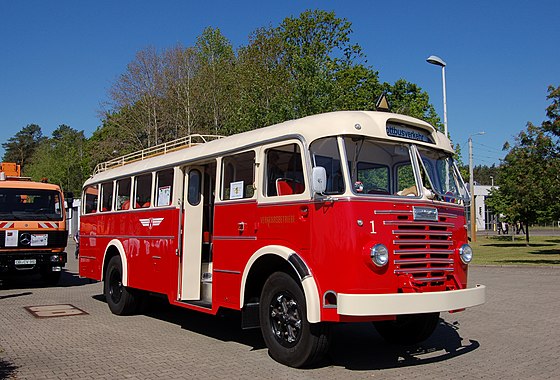Icarus 60
| Icarus | |
|---|---|

Ikarus 60 of the Hungarian AKÖV transport company, 1960 |
|
| Icarus 60 | |
| Manufacturer | Icarus |
| design type | Public bus (city bus / regional bus) |
| Production period | 1952-1959 |
| axes | 2 |
| engine | Csepel D-613 diesel engine in front |
| length | 9.54-9.60 m |
| width | 2.50 m |
| height | 2.90 m |
| Wheelbase | 5000 mm |
| Floor height | 680-880 mm |
| Empty weight | 7,750 / 8,200 kg |
| successor | Ikarus 630 |
The Ikarus 60 was an omnibus from the Hungarian bus manufacturer Ikarus and the forerunner of the Ikarus 630 , which was widespread until the 1980s and with which it shares basic technical features.
Technology and variants
In contrast to the Ikarus 66 , which was developed at the same time and which has a self-supporting body , the Ikarus 60 has an independent chassis with a superstructure. The original type intended for city traffic (23 seats and 32 standing places or 27 seats and 31 standing places) had two double folding doors for the passengers, the variant Ikarus 601 (37 seats, 10 standing places), a double folding door and the regional bus variant Ikarus 602 (40 seats, 15 standing places) one or two hinged doors opening outwards. Many vehicles only had a box for the line number above the windshield; the export variants often have a larger target sign box. The driver and passenger compartment, which can be entered via separate doors and which takes up a considerable area of the vehicle, was completely separated from the passenger compartment. Because of this and the arrangement of the doors, selling tickets for the driver was very cumbersome. The buses could therefore only be used to a limited extent in the conductorless operation that became established in the 1960s. Only a few vehicles of this type saw the introduction of payment boxes in the GDR transport companies.
Especially in the GDR and Hungary, the vehicles were often coupled with trailers . The Icarus 60 served at the Budapest transport companies as a base vehicle for conversions to articulated buses (types 600, 660), O buses (Type 60T) and joint-O buses (Type 400T); The trailers also had a shortened body of the motor vehicle. Some examples have been factory-equipped for special purposes (e.g. television broadcast vans, X-ray buses and ambulance buses).
use
The Ikarus 60 and its variants were used in other Eastern European countries and in the GDR as well as in their country of origin, Hungary. The Budapest transport company alone had 507 units in its inventory; About 600 pieces were exported to the GDR and 300 pieces to the USSR. In the GDR mainly the variants 601 and 602 drove; of the Ikarus 60 city bus variant are currently known: 26 vehicles for Dresden, five vehicles for Cottbus, at least four vehicles for Rostock and an unknown number for Erfurt.
In the GDR, the most recently heavily worn vehicles disappeared from regular service by the mid-1970s. Some were converted into work cars for the transport company, given to industrial or agricultural companies for works transport or to private bus companies. As of October 2019, three well-preserved specimens are known: The Budapest public transport company has a roadworthy Ikarus 60, which is used in nostalgic traffic, as well as a towable Ikarus 60T (currently without electrical equipment), which was restored in Szeged, both with a trailer. On May 19, 2019, the Cottbusverkehr transport company presented an operational Ikarus 601, which has been restored in 15 years of work.
Web links
- Page about the Ikarus 60 and variants with the history of their use by the Budapest transport company on www.old-ikarus.hu (Hungarian)
Individual evidence
- ↑ Märkische Oderzeitung from March 12, 2014 , accessed on July 5, 2015
- ↑ Page on Ikarus 60 at http://sovautoimport.narod.ru (Russian), accessed on August 28, 2016
- ↑ Historic motor vehicles of the Dresdner Nahverkehr eV , accessed on July 5, 2015
- ↑ Technical data of the buses in Cottbus at www.tram-cottbus.de , accessed on August 27, 2016
- ↑ From the horse tram to the hybrid bus - local public transport to Brinckmansdorf , accessed on August 27, 2016
- ↑ Long history: Trolleybuses in Erfurt , accessed on July 5, 2015
- ↑ Information on the vehicles and their use , accessed on October 20, 2019
- ↑ Photo of Michał Kwaśniak's trolleybus train on Flickr , accessed on August 28, 2016
- ↑ Cottbusverkehr: Aktuell, article from May 21, 2019 by Nicole Lempke , accessed on May 21, 2019


